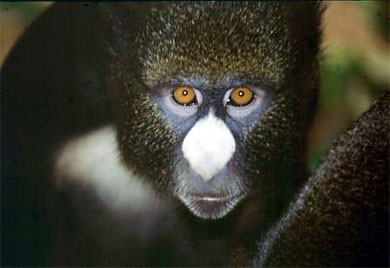Putty-nosed Monkey (Cercopithecus nictitans) {!--흰코원숭이--> Putty-Nosed Guenon
Cercopithecus nictitans
Appearance
A large, arboreal monkey with a long tail and dark, grizzled olive fur on the back, crown, cheeks, and base of the tail. The limbs and far half of the tail are black or dark gray. The monkey's most striking feature is a white nose spot which stands out against the dark face.
Bioko Subspecies
Cercopithecus nictitans martini is distinguished by a khaki-olive back and head, variable amounts of white and light gray on the underside, a white chest, and more vertically standing hair on the head.
Habitat and Distribution
The putty-nosed guenon is found on Bioko Island and on the mainland from north of the Zaire and Itimbiri rivers west to Nigeria and, in patches, on to Liberia. The monkey is found in all evergreen forests, from lowland to montane, primary, secondary, and narrow galleries and patches. It is uncommon in swamp or mangrove forests. Competing primates usually limit the putty-nosed's range rather than plant content.
Social Structure and Food
The putty-nosed monkey lives in groups of 12-30 females who defend a territory and are accompanied by a single adult male. Females give booming rallying calls, very loud 'pyows' and alarm hacks. They eat fruits, seeds, flowers, foliage and invertebrates. The male's diet consists of 58% fruits and 30% foliage while females consume 76% fruits and 12% foliage. Both sexes eat a similar proportion of insects, primarily caterpillars, ants and spiders.
